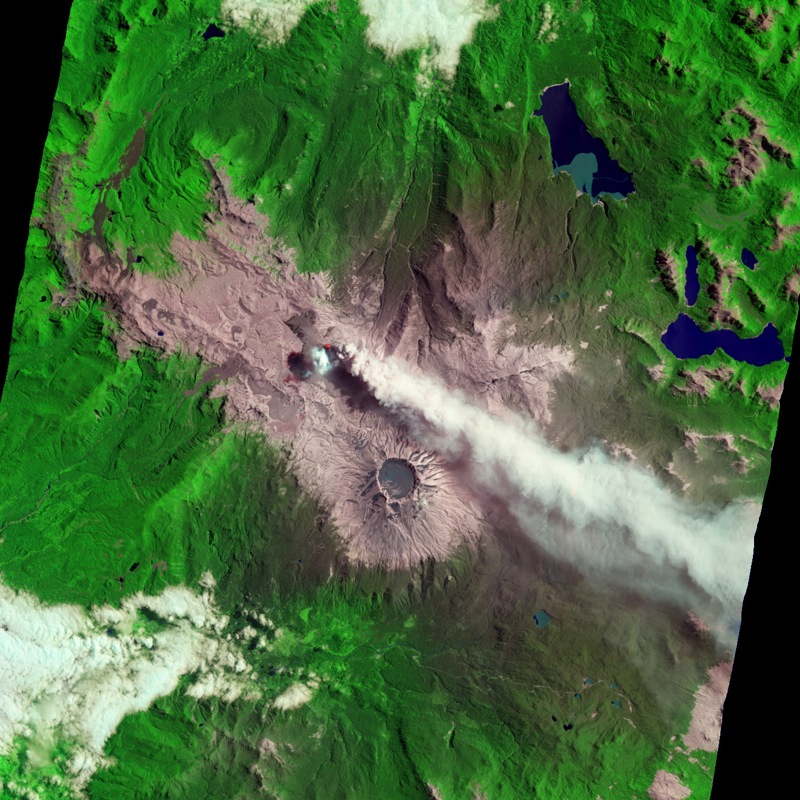Here are some images of the Puyehue-Cordón Caulle Volcanic Complex, two great volcanos that in Puyehue National Park in the Chilean Andes, the world’s longest continental mountain range. The NASA images were acquired on January 26, 2012, by the Advanced Land Imager (ALI) aboard the Earth Observing-1 (EO-1) satellite.
Puyehue-Cordón Caulle has been erupting almost continuously since June 4, 2011.
Amazing photos from Kilauea Volcano

NASA says about this image:
Eight months of ceaseless activity have covered the landscape around Puyehue-Cordón Caulle in ash. The light-colored ash appears most clearly on the rocky, alpine slopes surrounding the active vent and Puyehue’s 2,236 meter (7,336 foot)-tall caldera. Within the caldera, the ash appears slightly darker, possibly because it may be resting on wet snow that is melting and ponding in the South American summer.
The ash plume blows towards the southeast due to the prevailing winds. According to Chile’s Servicio Nacional de Geología y Minería (SERNAGEOMIN), plumes in the past week have reached two to four kilometers in altitude and have drifted 90 to 320 kilometers downwind.
Evergreen forests on the east side of the volcano have been damaged by months of nearly continuous ashfall, and are now an unhealthy brown. Forests to the west have only received intermittent coatings of ash and appear relatively healthy. The government of Chile has declared an agricultural emergency for the Los Rios region due to the destruction caused by ash falls. The Argentine government did the same for the farmlands and resort areas in Chubut, Neuquen, and Rio Negro. Airborne ash also continues to cause disruptions of air travel through the region and to Patagonia.

The image at the top of this post is the natural-color image. This bright green image is false color, acquired the same day as the first image. Look closely, and you’ll see how heat from the active vent colors it bright red. Just to the west of the vent, a blue-white cloud may indicate outgassing from the slowly-growing lava flow.
Puyehue-Cordón Caulle underwent occasional eruptions during the first part of the 20th century. Its last large eruptive episode began on May 24, 1960, 38 hours after the main shock of the 1960 Valdivia earthquake, the largest earthquake recorded in history, which had an estimated moment magnitude of 9.5. In that year, Puyehue-Cordón Caulle’s eruption last until July.
The world was less populated in 1960, and in particular this part of the Chilean Andes was sparsely populated and isolated. So, partly because of the damage caused by the huge earthquake itself, the 1960 eruption of Puyehue-Cordón Caulle received little attention by the media. It’s said to have had few eyewitnesses.
Since 1960, Puyehue-Cordón Caulle was quieter – until the June 4, 2011 eruption began. In our more populated world, the impacts of the start of a new eruption were greater. Several thousand people were evacuated from nearby areas, and airports as far away as Buenos Aires, Argentina and Melbourne, Australia had to be closed temporarily due to volcanic ash.
Bottom line: The Puyehue-Cordón Caulle Volcanic Complex in Chile has been erupting almost continuously since June 4, 2011.. The NASA’s Earth Observing-1 (EO-1) satellite acquired images of the volcano on January 26, 2012, with its Advanced Land Imager (ALI). The last major eruption of Puyehue-Cordón Caulle was in 1960, following a 9.5-magnitude earthquake.











